Filipinos and Paris Olympics, After 100 Years
In a few weeks, the Summer Olympics will be upon us again. It marks 100 years since the modern Olympics was last in Paris and also the centennial of Pinoy presence in the Olympic Games. Oo la la!
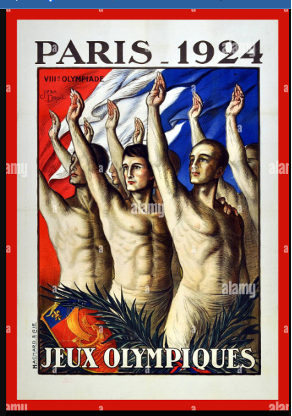
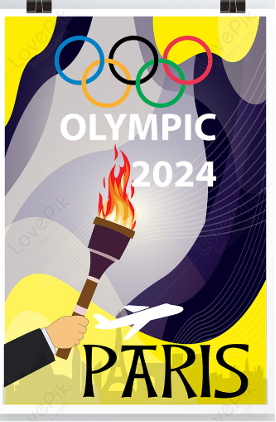
Sports Skewed for Bigger Physiques
Before we get any further, this would be the opportune time to air my beef and examine the whole question of the “universal appeal” that the modern Games is trying to promote. For the ancient Greek Games, just a handful of Mediterranean city-states and a few guest kingdoms competed, but the male entrants were all about the same physiognomy (i.e., similar heights, similar builds, etc.) hence, the featured sports weren’t anything incompatible to those ancient athletes.
When the Philippines made its Olympic debut in 1924, the indigenous Malay peoples had already developed their own sports and diversions fitting their own smaller builds but could not compete since their indigenous sports weren’t internationally codified and recognized. Hence, the Philippines, like all the developing nations, were forced to participate in “sports” that were originally designed for western physiques.
When Spain ruled its colonies, sports wasn’t a big deal. It was religion and polo for the Spanish viceroys and the ruling classes who indulged in said “sport of kings.”
The American takeover made it worse for Filipino athletes. The Americans, on the whole taller and bigger than the Spaniards, then introduced a whole new set of sports, a few of which they had belatedly invented: basketball, volleyball, baseball, and which naturally favored bigger, taller, longer-limbed, overall stronger individuals which the average Filipinos were not. Taller athletes reached the nets more easily and made successful shots or spikes. The shorter Filipinos were always playing catch-up or just played supporting roles; but the stars of the competitions were the bigger players.
(Of course, if the modern world as we know it today had been dominated by the “more compact” peoples of the planet—the South Asians, the non-Tutsi African tribes, the First Nations, the Amerindians and Mesozoic peoples of the New World—and it was their sports that made up what we know today as the Olympics—then it would be, to use a pun, a whole different ballgame. But one can dream of a better, more equal world, can’t one?)
Starting in the 1950s-‘60s, the IOC began adding sports like judo, table tennis, taekwondo, badminton, field hockey, etc., which did not necessarily favor bigger, stronger bodies, to allow for greater participation of Asians whose countries were having greater global clout as well as starting to host these expensive Games.
First Philippine Olympic Team
Thus, a hundred years ago, even though the Philippines was not its own sovereign state, a new “Philippine” Olympic team showed up at the big sports pow-wow in Paris 1924. For a group of islands named after a Spanish king but only briefly hoisting its own flag for a nanosecond, the Philippines was ready to make its international sports debut, even with an inaugural team consisting of only two individuals: Dr. Reginio Ylanan, an official, and the lone athlete, David Nepomuceno of Oas, Albay.
I wish more could have been written about sprinter Nepomuceno’s performance as the trail-blazing Filipino Olympian, but unfortunately, Nepomuceno did not advance past his heats in the 100m and 200m sprints.
[For the record, along with the Philippines, eight other new nations/territories (Bulgaria, Ecuador, Ireland, Latvia, Lithuania, Poland, Romania, and Uruguay) made their Olympic debut at those Paris 1924 Games. Coincidentally, those nine new countries were all Christian or Orthodox. The 1924 Games were those made famous in the Academy Award-winning movie, Chariots of Fire (1981) although the film distorted basic facts to achieve a major story conflict that dramaturgy requires.]
In prepping for this article, I was successful in at least making contact with Joanie Delgaco (our first Filipina rower—more about her later) but it was disappointing as a whole to get no feedback or even interest at all from the present Philippine Olympic Committee (POC) or any response from two of the other trailblazers mentioned in this piece: first gold-medalist Arianne Cerdeña and first Filipino tobogganer Raymond L. Ocampo, Jr., both of whom are alive and well in California. Regarding the POC, the Journal of the International Society of Olympic Historians (ISOH, of which the author is a member) asked me to prepare a piece marking the Centennial-participation of the Philippines in the Olympics. However, attempts to reach out to the POC even a full year ago, were rebuffed. As the French hosts would say, quel dommage, overall, a loss for Philippine history.
Some other early Filipino Olympians worth mentioning:
At Amsterdam 1928, Simeon Toribio won a bronze in the High Jump. He competed again in LA 1932 and carried the flag at Berlin 1936. Back in the Philippines, he went on to public life. Toribio died in 1963.
Then there are father-and-son boxers Jose and Anthony Villanueva, among the rare parent-son pairings of Olympic athletes who have both won medals in their respective Games. Jose won a bronze at Los Angeles 1932 and Anthony, a silver at Tokyo 1964. Of course, Jose won while the country was still a Commonwealth and Anthony triumphed in an already independent Philippines.
Sharpshooter Martin Mauricio Gison holds a unique record in Philippine sports history. He holds the record for Olympic participation longevity, having competed in five Olympic Games (Berlin 1936, London 1948, Helsinki 1952, Melbourne 1956, and Tokyo 1964) over a 28-year span. And in-between those years, Gison survived the Bataan Death March.
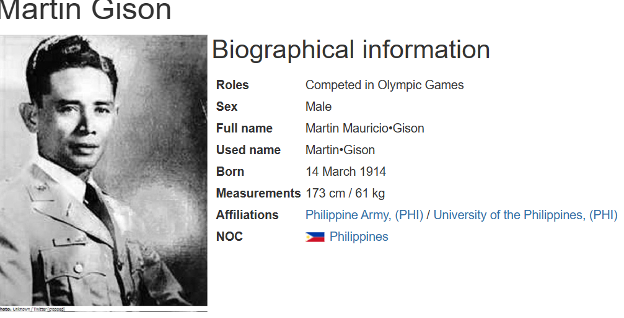
Tokyo 1964 also saw the participation of the first two Filipinas in Gymnastics: Maria Luisa Floro and Evelyn Magluyan. Strangely, after Gison’s last participation at the Tokyo 1964 Games, there is no record of what happened to him after, not even a date of death.
First Winter Games Participation
In 1972, at the first Winter Olympic Games held in Asia, in Sapporo, Japan, the Philippines made its Winter Games debut. The tropical country was represented by a pair of teenage Filipino-Kiwis Johnny Cipriano and Benjamin Nanasca. The boys, blood cousins, had been adopted as children by a New Zealand couple but grew up mostly in Europe because of the foreign assignments of their adopted parents. They learned to ski, in of all places, Andorra. Since then, the Philippines has had similar token participation in a few Winter Games.
Moscow 1980
In the 100-year history of its Olympic participation, only once has the Philippines missed out on showing up. That was for Moscow 1980. Despite the fact that the Marcos administration had just established diplomatic relations with then-Soviet Union in 1976, the POC joined 40-other allied nations in the boycott (led by the US) of the Moscow Games. The martial law rule of Ferdinand Marcos was ineffective in overruling the POC. The year 1980 was also when Jorge B. Vargas, the first Philippine member of the IOC, passed away.

The Gathering of Nations at the Opening Ceremony of Paris 1924 at the Colombes stadium—taking the Athletes’ Olympic Oath. (Source: International Olympic Committee)
Historic 1988 and Forgotten First Olympic Gold Medal
There were three historic but often forgotten Philippine sports “firsts” in 1988:
At the Winter Games in Calgary, the lone Philippine athlete was Raymond L. Ocampo, Jr., who entered in the one-man luge (or toboggan). Ocampo’s feat as a winter athlete for a tropical country that year, was overshadowed by the Jamaicans’ bobsleigh quest made famous in the movie Cool Runnings. I guess a team of four “misplaced, tropical athletes” is more newsworthy than just one, lone tobogganer. Ocampo hailed originally from Lubao, Pampanga. He had a successful corporate-legal career in the SF Bay Area.
The 1988 Summer Games held in Seoul, South Korea was only the second time the Games were staged in Asia. The Paralympic Games were also officially tacked on after the regular, able-bodied set of Games that year. The Paralympics (run by the International Paralympic Committee, based in Bonn, Germany) are for disabled/handicapped athletes. The Philippines sent its first-ever Paralympic team to Seoul 1988.
Also, in Seoul 1988, the Philippines won its first-ever gold medal, by Arianne Cerdeña. Her accomplishment is often forgotten because Bowling was a “demonstration” sport in 1988. “Demonstration sports” at an Olympic Games are often considered saling-pusa (consolation) material because they are not part of the regular core Olympic sports. But a gold medal is still a gold medal. The medals awarded are exactly the same as those given to the winners of the other “regular” Olympic sports.
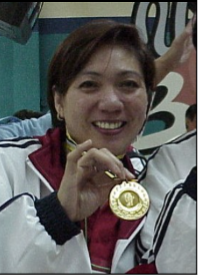
Arianne Cerdeña, the first Filipina Olympic gold medal winner, Seoul 1988. (photo c/o Wikipedia, is not of the Olympic gold medal won in Seoul.)
The Paralympics and First Paralympic Medal
But it was not until Sydney 2000 that the Paralympic Games produced the first Filipino medalist. That was powerlifter Adelina Dumapong who picked up the bronze medal in the up-to-82.5kg category. (Dumapong’s first Paralympic bronze medal in 2000 seemed to be a foreshadowing of Hidilyn Diaz’s two later medals in Rio 2016 and Tokyo 2020 when Diaz finally won the first (regular) Olympic gold in the 55kg category.
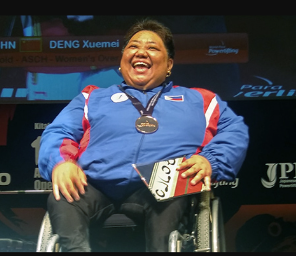
Adeline Dumapong-Ancheta, first Paralympic medalist for the Philippines, Sydney 2000.
Note that the Philippines’ first Olympic gold medalists (1988 and 2020) and its first Paralympic medalist (2000) were all women!
Paris ’24 – Cherchez la Femme (Look for the Woman)
In picking its logo, Paris 2024 not only unabashedly chose an image portraying “Marianne” (the allego-rical symbol of France), but the organizers also promised to make 2024 the first modern era Olympic Games achieving full gender-parity (i.e., equal number of sports and athletes between the two genders).
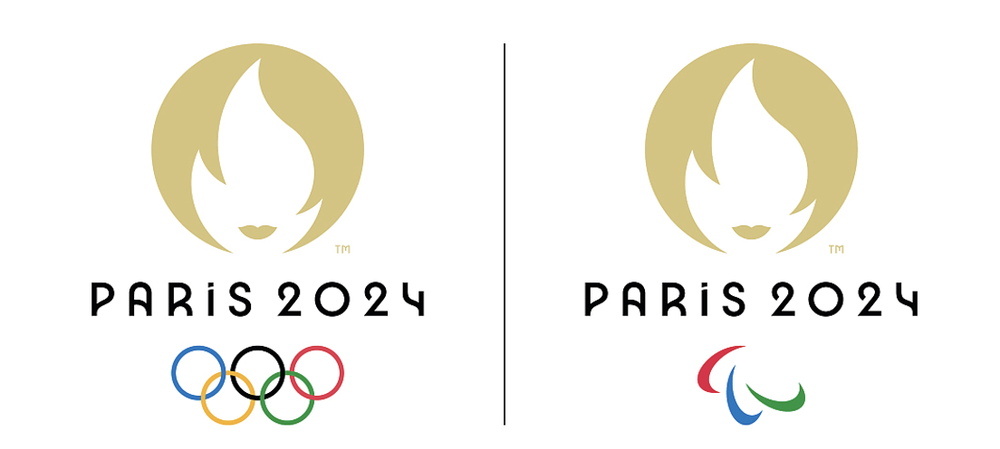
Logos for the Paris 2024 Olympic and Paralympic Games (right: which follow later in August). The silhouette of the “flame” is superimposed upon “Marianne,” the allegorical symbol of France. (© Paris 2024)
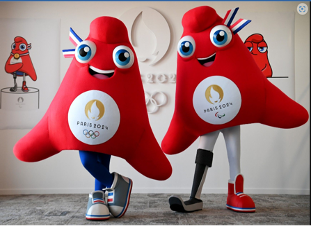
The 2024 mascots—the Phyrges, based on the Phyrgian caps. The Paralympic mascot, right, sports a prosthetic leg.
There was a chance to make Olympic history again by seeing the first male swimmer compete in the otherwise all-female sport of Artistic Swimming (formerly Synchronized Swimming), but it’s not going to happen this year.
But Paris 2024 will see women archers for the first time, from seven(!) countries: Azerbaijan, India, Iran, Moldova, Poland, Slovakia, and Ukraine, in the “recurve” category. The Philippines will send its first Paralympian archer in Agustina Bantiloc who, at 55, could be the oldest (female) Paralympic archer in history. Finally, for the first time, the women’s Olympic marathon will be given the place of honor by being the Closing race of the Games on the last day, a spot usually reserved for the men’s race.
Best 2024 Pinoy Medal Prospects
For this 2024 team, there will be seven men and fifteen women competing in nine Olympic sports; and three each per gender in the Paralympics—all in individual competition; no Philippine team entries this year. As of press time, the four best, most promising opportunities for a Paris medal are:
Pole-vaulter Ernest John Obiena. Never before has the Philippines gotten so close to an Olympic gold medal in athletics (or Track & Field), so often dominated by the US, Germany, and Russia as with pole-vaulter Ernest J. Obiena, who is ranked #2 in the world behind Armand “Mondo” Duplantis of Sweden.
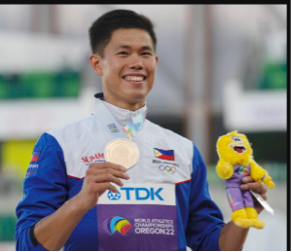
EJ Obiena
Obiena hails from Tondo, took his secondary education at Manila’s Chiang Kai Shek College and then went to UST for college. When Duplantis wasn’t around, Obiena has won gold; but with Duplantis present, Obiena can’t seem to overtake the eight-world-records-holder in the sport. The last world record achieved by Mondo was 6.24m. There is also a trio of American pole vaulters nipping at Obiena’s heels who are determined to bring back the pole vault gold to the USA. It'll take a freak mistake by Duplantis and some luck for Obiena to grab the gold from Duplantis and the three Yanks in Paris. A silver would be OK, too.
Boxer Eumir Marcial returns and is looking to improve on the middleweight bronze medal he won in Tokyo 2020. This time he will compete in the light heavyweight division.
Gymnast Carlos Edrel Yulo who has done so well in the World Championships and other meets. But he failed to medal in Tokyo 2020, which should have been like home turf for him since he trained in Japan.
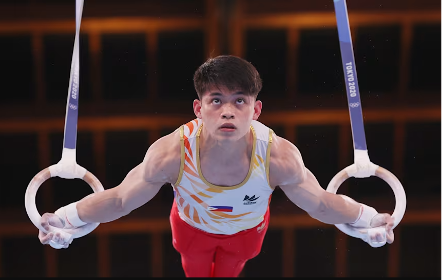
Carlos Yulo in fighting form on Rings in Gymnastics.
Paris probably presents Yulo’s last best hope for an Olympic medal or two. While still a quadruple threat in Parallel Bars, the Vault, Rings, and Floor Exercise, Yulo is already 24 years old this year, about the peak year for gymnasts’ bodies. If he goes again for the LA Games of 2028, can his body sustain another four years’ training, without injuries, when there will be newer, fresher, less injured gymnasts also going for LA28 gold?
In Swimming, the Fil-Canadians will be represented by Kayla Noelle Sanchez of Team Pinoy 2024. She is already the most medaled Olympics returnee. Sanchez will be competing for the Philippines by way of Canada and Singapore where she was born. Her folks immigrated to Canada where Kayla found her fins as an elite swimmer. Sanchez hopes to add to her medal haul from Tokyo 2020 (a silver in the women’s 4x100m freestyle relay and a bronze in the 4x100m medley relay for Canada), this time representing a new countryin the individual 100m Free.
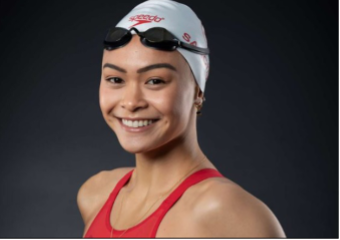
Swimmer Kayla Noelle Sanchez by way of Singapore and Canada.
Since there wasn’t enough time to secure Philippine citizenship for Kayla, the POC sought exemptions from both the World Aquatics and the IOC for her to represent the Philippines in Paris 2024. Kayla first swam for the Philippine flag at the 2022 Asian Games. Under the new “Universality” principle in which the IOC adds more athletes from under-represented nations, thereby enlarging the, to use a pun, “pool” of competing nations. But constrained by the limit of 10,500 beds at the Olympic Village(s), the IOC waived its three-year residency change for Kayla in order for her to swim for the Philippines in Paris.
More Artistic Gymnastics
Caloy Yulo will have strong Pinay female companionship thanks to a trio of Fil-Am gals—Levi Jung Ruivivar, Aleah Finnegan-Cruz and Emma Malabuyo—with Team USA Gymnastics credentials and strong collegiate training from the USA’s top universities in the sport. They who mostly got in via the Universality Place category.
Ruivivar became the first to qualify for an individual spot in the Women’s Uneven Bars category.
Finnegan-Cruz, originally from St. Louis, Missouri, is no stranger to Fil-Am expat representation of the old country. One of her older sisters had represented the Philippines in 2011; so, when Aleah failed to make the highly competitive US team rankings this year, she sought a place on the Philippine team which also sought her out. Aleah is presently studies and trains at Louisiana State University.
Finally, Californian Emma Malabuyo, an alternate for the US Gymnastics team in Tokyo 2020, earned her way to a 2024 Philippine spot by capturing the bronze medal at the Women’s Artistic Gymnastics Asian Championships in Tashkent, Uzbekistan. Malabuyo is currently a star at UCLA. BTW, the three 2024 Fil-Am lady gymnasts are all making their Olympic debut.
Rowing
As befits a feminine-equal Games, the Philippines will be able to send for the first time its first female rower, Joanie Delgaco*, a home-grown single sculler, open weight.
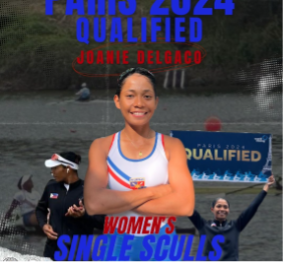
Joanie Delgaco, first ever Filipina solo Olympic rower
Delgaco will be competing in Single Sculls, open weight division, that is one-oared rowing in flat water. In the Philippines, Delgaco trains at the La Mesa Dam Eco Park. I asked her if she brings her own scull (boat) when she goes to the meets? “No,” she answered. “I will be bringing only my oar.” The (certified and uniform) boats are rented for a minimal fee at the regatta location in Paris.
Fencing
As befits a feminine-equal Games and in the homeland of the original trois musketeers (Athos, Porthos, and Aramis), the Philippine team will be sending a new first to the Olympic Games, a lady fencer, *Samantha Catantan. She will be competing in Foil.
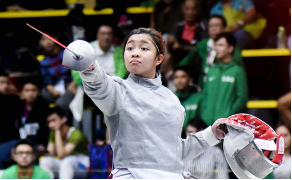
First Filipina Olympic fencer Samantha Catantan.
As of June 30, 2024, here are the rest of the Team Filipinas 2024:
1. Ando, Elreen Ann* (she – Weightlifting, 59kg)
2. Ardina, Dottie* (she – Golf)
3. Bacyadan, Hergie* (she – Boxing, 75kg)
4. Ceniza, John* (he – Weightlifting, 61kg)
5. Hatch, Jarod* (he – Swimming, 100m Butterfly)
6. Hoffman, Lauren* (she – Athletics, 400m hurdles)
7. Paalam, Carlo (he – Boxing, 57kg; won a silver medal at Tokyo 2020.)
8. Pagdanganan, Bianca (she – Golf)
9. Petecio, Nesthy (she – Boxing, featherweight; won a silver medal at Tokyo 2020.)
10. Sarno Vanessa* (she – Weightlifting, 71kg)
11. Tolentino, John Cabang* (he – Athletics, 110m Hurdles)
12. Villegas, Aira* (she – Boxing, 50kg)
13. Watanabe, Kiyomi (she – Judo)
* - making their Olympic debut.
Pinoy Paralympic Team 2024
And the six Paralympians who will compete in the Parisian Paralympic fields starting August 28, 2024:
- Asusano, Cendy (she – Athletics, Javelin – Paralympic debut)
- Bantiloc, Agustina (she – Archery – Para debut at age 55!)
- Ganapin, Allain (he – Taekwondo – Para debut)
- Gawillan, Ernie (he – Swimming – 3rd Paralympic Games)
- Mangliwan, Jerrold (he – Athletics, Wheelchair Racing – 3rd P.G.)
- Otom, Angel (she – Swimming – Para debut)
Bonne chance to all our Team Filipinas 2024 athletes.
A New World Championships in Manila Next Year
If no French hardware returns home to Manila this year, there is one more world-class event that Filipino sports fans can look forward to next year. Manila will be hosting the 2025 FIVB Men’s Volleyball World Championships in September 2025. The Philippines was uniquely chosen to be the lone host to 32 teams next year. This is a big deal. Those championships are usually given to nations with powerhouse volleyball teams who, because of their domestic fan bases, would ensure high fan attendance at the matches. But they broke that template for next year.
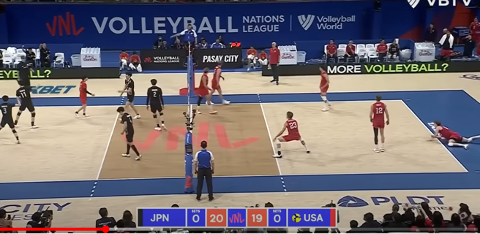
The SM Mall of Asia Arena and Smart Araneta Coliseum will be the two main venues for next year’s 2025 FIVB Men’s Indoor Volleyball World Championships. (Screengrab from VNL 2024’s Japan-USA match at Mall of Asia.)
It will be the first time the tournament is entrusted to a non-volleyball powerhouse nation because Filipino fans have taken to volleyball like basketball in recent years and treat the foreign spikers like rock stars; there’s endless screaming at matches as if they’re rock concerts. To qualify for the tournament and fill out the 32 slots, Filipino Men’s Indoor Volleyball team, which ranked #36 in the world, was elevated to #32. But Filipino fans must also be realistic because Volleyball, indoor or beach, is a sport for tall people.
Uncertain Sport for LA28
After Paris 2024, the Games return to Los Angeles in 2028. Unfortunately for Filipinos, the one Olympic sport Filipinos excel in, Boxing, faces an uncertain Olympic fate in four years’ time. The sport is the last holdout in that its federation, the International Boxing Association (IBA), continues to contravene the IOC in the issues of drugs and biased judging, forgetting that the IOC owns and runs the Olympic Games. So, Filipino athletes must try and compete in other sports appropriate for the smaller Pinoy physiognomy. Maybe boccia (bocce ball) in the Paralympics? Or Curling for the Winter Games?
Olympic medals vs. Other International Titles
So, how has the Philippines fared after one century of Olympic participation, having now competed in Athletics, Basketball, (Bowling), Boxing, Fencing (new for 2024), Figure Skating, Golf, Gymnastics, Sailing, Shooting, Skiing (Downhill), , and Weightlifting (among the core 25 summer and 9 winter Olympic sports)?
Compared to other international titles, the Philippines is indeed far behind (15 Olympic/Paralympic medals including Cerdeña’s 1988 gold and one bronze Paralympic medal) for 100 years’ participation vs. more than two dozen international beauty pageant titles (the country has won at least every one of the international pageants it has participated in once, since 1963) and vs. one co-shared Nobel Peace Prize. For a tropical country with a not very strong sports tradition, the Philippines’ Olympic/Paralympic medal haul is about where it should be, all things being equal.
But come July 26, the world’s greatest sporting event opens again in the beautiful City of Light after a century’s absence. Pass me that napoleon and glass of Beaujolais while you’re at it si’l vous plait.
SOURCES:
Philippine Olympic Committee (archive.org)
David Nepomuceno 1st Filipino Olympian | Pinoyathletics.info
Cipriano - Olympian part of Youthtown history | Stuff.co.nz
Paralympics - Philippines Paralympics - Rio 2016 Medals, Athletes & News
Philippines focuses on World Aquatics Championships... and Paris 2024 (insidethegames.biz)
Seven countries add women's recurve Olympic spots (insidethegames.biz)
Duplantis breaks own pole vault world record at Xiamen Diamond League (insidethegames.biz)
Chasing Mondo Duplantis: In Olympic pole vault, a trio of Americans try to topple a giant (msn.com)
Doha Artistic Gymnastics World Cup ends, 20 more athletes for Paris 2024 (insidethegames.biz)
Emma Malabuyo earns Olympic berth with all-around bronze in Asian championships (rappler.com)
IOC waives residency, giving Kayla Sanchez green light to chase Paris medal | Inquirer Sports
The Filipino Athletes Qualified For The 2024 Olympics (thegame-onemega.com)
Philippines locks in hosting rights for Men’s World Championship 2025 | volleyballworld.com
World Boxing 'welcomes' CAS decision to withdraw recognition from IBA (insidethegames.biz)
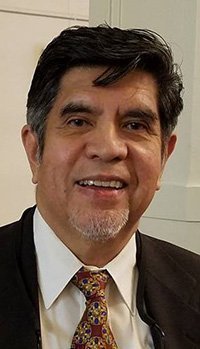
Myles A. Garcia is a Correspondent and regular contributor to www.positivelyfilipino.com. He has written three books:
· Secrets of the Olympic Ceremonies (latest edition, 2021);
· Thirty Years Later . . . Catching Up with the Marcos-Era Crimes (© 2016); and
· Of Adobo, Apple Pie, and Schnitzel With Noodles (© 2018)—all available in paperback from amazon.com (Australia, USA, Canada, UK and Europe).
Myles is also a member of the International Society of Olympic Historians, contributing to the ISOH Journal, and pursuing dramatic writing lately. For any enquiries: razor323@gmail.com
More articles from Myles A. Garcia






No comments:
Post a Comment